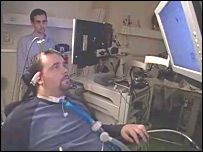
In the future it will be possible to implant a chip in the brains of paralyzed people and allow them to control their movements. He was able to move objects only with the power of thought. The experimental chip allows a person who cannot move his limbs completely, to open email, play computer games, and "pinch" with prosthetic fingers.
The American team that developed the sensor hopes that the new technology will one day be able to integrate into the body and allow paralyzed people to move their limbs independently. The study, conducted by team members from the Massachusetts Institute of Technology, was published in the journal Nature.
Mathew Nagel, left paralyzed from the neck down and confined to a wheelchair after a stabbing attack in 2001. At the age of 25, he was the first patient to try the brain sensor.
A team of scientists implanted in Nagel's brain, in the area known as the motor cortex that is responsible for voluntary movement, the device - a neuro-motor prosthesis Neuromotor Prosthesis (NMP). The NMP contains an internal sensor that detects the activity of brain cells, and an external sensor that converts this brain activity into signals that can be recognized by a computer.
Although his spine was severely damaged during the three years leading up to the experiment, the scientists found that the brain cell activity, or electrical patterns, were preserved within his motor cortex.
The electrodes in the NMP were able to pick up the brain activity and send it to the computer. The computer translated these electrical patterns into movement commands, which could drive computer controllers or artificial arms.
Using the device, Nagel was able to move the computer cursor to open e-mail, play simple computer games, open and close a prosthetic hand, and grasp and move objects with a robotic arm.
Nagel testifies that the sensor allowed him to perform some actions independently, for example turning the lights on and off, an action that was previously performed for him by a nurse.
The main researcher in the project, Dr. Lee Hochberg, a neurologist at the Massachusetts Central Hospital, said: "One of the exciting results of the experiment is that this part of the brain, the motor cortex, can act voluntarily in the hands of this person who suffers from a severe spinal cord injury. The fact that this activity still exists, despite the injury that happened a few years ago, encourages us a lot because it proves that we have the ability to use these signals to control external devices."
His research partner, Prof. John Donio, director of the neuroscience program at Brown University and chief scientist at Cyberkinetics, the company that built and tested the sensor, added: "This result holds the promise that one day we will be able to activate the arm muscles using brain signals, and to effectively restore the brain's control over the muscles with the help of a physical artificial nervous system."
It is worth noting that another experiment with the device, in a 55-year-old man, failed, when the device failed to receive the brain signals.
Drafting and editing: H. J. Glykasm, translations and technical writing

